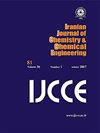氮素沉降对冻融潜伏期土壤CO2排放的影响
IF 1
4区 工程技术
Q4 CHEMISTRY, MULTIDISCIPLINARY
Iranian Journal of Chemistry & Chemical Engineering-international English Edition
Pub Date : 2021-10-12
DOI:10.30492/IJCCE.2021.521605.4482
引用次数: 0
摘要
由于传统的土壤氮沉降对冻融期土壤排放影响的分析方法,没有对冻融潜伏期土壤氮沉降对土壤排放的初始影响进行分析,导致后期分析结果准确性不足。提出了一种分析冻融栽培过程中氮素沉降对土壤排放影响的新方法。在此基础上测定了土壤温度、水分、无机氮和可溶性碳的含量。建立了3种氮沉降水平冻融模型。采用多变量方差分析方法,研究了高寒湿地氮沉降对土壤排放的影响以及氮沉降对土壤排放的影响。研究了氮沉降对高寒湿地排放的影响。结果表明:不同土壤温度和含水量对土壤通量的季节变化影响较大,总体上与土壤温度单峰一致,但与不同生育期土壤含水量的变化高度一致。施氮处理改变了土壤有机质中DOC含量。低、中氮处理显著提高了无机层和有机层的DOC含量。冻结期土壤排放量低于常温期,多次冻结期土壤排放量小于一次冻结期土壤排放量。冻融条件下土壤的排放率最小,解冻后土壤的排放率最大。适当的氮沉降可以促进土壤排放,而高的氮沉降可以抑制土壤排放。本文章由计算机程序翻译,如有差异,请以英文原文为准。
Effect of nitrogen deposition on Soil CO2 emission during freezing-thawing incubation period
Due to the traditional analysis method on the influence of soil nitrogen deposition on soil emissions during the freezing and thawing period, the initial impact of nitrogen deposition on soil emissions during the freezing and thawing incubation period was not analyzed, resulting in insufficient accuracy of the later analysis results. A new method was proposed to analyze the effect of nitrogen deposition on Soil emission during freeze-thaw cultivation.On this basis, the contents of soil temperature, moisture, inorganic nitrogen and soluble carbon were determined. Three freeze-thaw models of nitrogen deposition levels were established. The influence of nitrogen deposition on Soil emission and the effect of nitrogen deposition on emission in alpine wetland were studied by multivariate variance analysis. The effect of nitrogen deposition on emission of alpine wetland was studied. The results showed that different soil temperature and moisture content had great influence on the seasonal variation of soil flux, which was generally consistent with the single peak of soil temperature, but highly consistent with the variation of soil moisture content in different growth periods. Nitrogen treatment changed the DOC content of soil organic matter. DOC content in mineral layer and organic layer increased significantly in low and medium nitrogen treatments. The emission of soil in freezing period is lower than that in normal temperature period, and that in multiple freezing period is less than that in one freezing period. The emission rate of soil under freeze-thaw condition is the smallest, and the emission rate of soil after thaw is the largest. Appropriate nitrogen deposition can promote soil emission, while high nitrogen deposition can inhibit emission.
求助全文
通过发布文献求助,成功后即可免费获取论文全文。
去求助
来源期刊

Iranian Journal of Chemistry & Chemical Engineering-international English Edition
CHEMISTRY, MULTIDISCIPLINARY-ENGINEERING, CHEMICAL
CiteScore
2.80
自引率
22.20%
发文量
0
审稿时长
6-12 weeks
期刊介绍:
The aim of the Iranian Journal of Chemistry and Chemical Engineering is to foster the growth of educational, scientific and Industrial Research activities among chemists and chemical engineers and to provide a medium for mutual communication and relations between Iranian academia and the industry on the one hand, and the world the scientific community on the other.
 求助内容:
求助内容: 应助结果提醒方式:
应助结果提醒方式:


